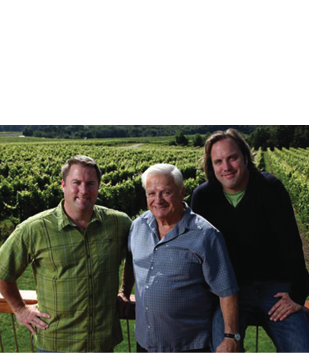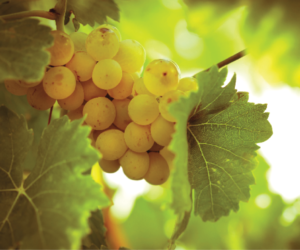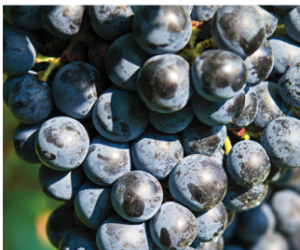If you live in a place with cooler weather and want to grow a versatile vinifera varietal, Riesling might be your best bet. Think Germany and Austria when you think of a climate for Riesling. In this issue, we asked two Riesling experts to discuss how they grow their grapes and how you can use those tips in your own home vineyard.
Sean O’Keefe, V.P./Trade Relations at Chateau Grand Traverse in Traverse City, Michigan (far right). Sean studied German literature at the University of Michigan and moved to Germany in 1994 where he apprenticed at the winery of his family’s former winemaker (at Chateau Grand Traverse), Weingut Jakob Pfleger, in the Pfalz. He also attended viticulture classes at the nearby wine school in Neustadt. He transferred the following year to the wine university in Geisenheim in the Rheingau, where he fell in love with Riesling in all its forms.
Our vineyard’s first test field planted Riesling in 1974. The first commercial planting was in 1976. We currently cultivate more than 80 acres of estate Riesling, and have long term contracts for an additional 60 acres on the Old Mission Peninsula in Michigan. Our original estate vineyard was planted with Neustadt Clone 90 and Geisenheim Clone 239. Since then we’ve established vineyards with a whole range of different clones (Geisenheim 198 and 110, Neustadt 365, Weis 21-B, Colmar 49, Bernkastel-68). Clone 239 is by far our favorite, most planted clone. I would love to get my hands eventually on the “heirloom” clones that they are currently cleaning up and propagating in Germany.
My father saw the Old Mission Peninsula as ideally suited to producing world-class Riesling on par with the wines he loved from the classic growing regions of Germany, Austria and Alsace. It’s a narrow 18-mile long peninsula that juts into the Grand Traverse Bay of Lake Michigan terminating at the 45th parallel. It’s long been a major fruit-growing region (especially tart and sweet cherries) because of the temperature moderating effects of the surrounding deep waters. The cool waters typically delay bud break until early May so that we avoid harsh frosts, and then our sunny location near the 45th parallel helps move things along quickly so that we see veraison in late August. It’s the length of ripening time between veraison and harvest that I consider the most crucial for producing high quality/memorable Riesling. It cools down steadily in September and October in Northern Michigan, which slows down sugar accumulation and preserves Riesling’s crucial acidity. Nighttime lows can often dip down into the mid 30s and 40s °F (2 to 7 °C) as we near November, but once again it rarely frosts because of the surrounding water. My favorite Rieslings are usually picked at the very end of October/early November when the skins and grape flesh are fully ripened, but still maintaining fresh acidity and low pH.
Riesling vine spacing is dependent upon the site’s fertility. We prefer 4.5-foot vine spacing for our sandy loam soils, and tighter spacing for sandier/low vigor soils. We could probably tighten up the rows to 8-foot for future plantings, though 9-foot gives us room (especially on steeper hillsides) to safely mechanically till weeds and spread compost.
The hardest part about growing Riesling on the Old Mission Peninsula is achieving even ripening across vineyard blocks. Our soils are primarily sandy loam/glacial till, though there is usually
a hodgepodge of clay lenses and sand scattered randomly through the vineyards that strongly affect vigor and ripening. All it takes is a small percentage of green, not fully matured grapes to compromise the quality of the wine, especially in dry styles.
I’ve found that Riesling likes to grow where either peaches or sweet cherries were once successfully cultivated. Don’t plant Riesling in marginal vineyard sites just because it’s considered “cold-hardy” and then expect good results. Consider Riesling on its own terms as a variety, and realize that it typically achieves full ripeness at <21–22 ˚Brix; it’s about the interplay of acid and fruitiness, not alcoholic strength that give Riesling balance!
Dave Weimann, Vineyard Manager at Sheldrake Point Winery in Ovid and Hector, New York. Dave’s background includes four years of grapevine management at Cornell University’s Geneva Agricultural Experiment Station and two years of honeybee research in Ithaca.
I started growing Riesling back in 1992 at Cornell’s Geneva Agricultural Experiment Station where we grew it for experimental use. The Finger Lakes are a great place to grow Riesling because we have summers that are not so hot, but the cooler weather, especially during harvest, preserves the acidity and give the wines their distinctive backbone and makes it what it is.
I started out growing Riesling at Sheldrake with Vertical Shoot Positioning (VSP) trellising. While the vines were young that worked okay, but as they aged they required a switch to a Scott Henry system, which allows for twice as much foliage and twice as many grapes. Getting the right number of shoots and the right amount of fruit on the vine is critical.
When it comes to vine spacing, it would be ideal if you could come up with the right spacing before planting. Here at Sheldrake 6- by 8-foot spacing works well, but it’s all about how vigorous the vines are.
For me, one of the bigger challenges is vine balance and getting the right amount of shoots without letting them get so big. You also need to get the right amount of fruit so that berries don’t get too big — you don’t want to get cluster closure too early otherwise disease pressure gets very high. When the cluster is closed you can’t get air, sunlight or spray into the cluster anymore.
If you’re thinking about growing Riesling, look for a site that is not good for farming. Sites that are not good for standard farming are good for grapes. If you have vigorous soil you’re going to have a hard time keeping the vine and berry size down to where you can manage them. Look for a site with weak, gravelly soils so that you will have better control over the variables — you can add vigor in, but it’s hard to take away.







